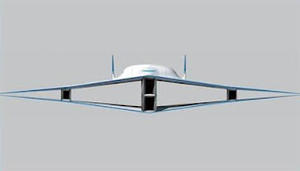AviationBi-plane to revive supersonic travel
Researchers say that the best way to revive supersonic air travel – which came to an end with the retirement of the Concorde in 2003 – would be by building a plane with two wings to a side; computer models show that a bi-plan produces significantly less drag than a conventional single-wing aircraft at supersonic cruise speeds

Head on rendering of supersonic biplane concept // Source: nextbigfuture.com
For twenty-seven years, the Concorde provided its passengers with a luxury they could not get elsewhere: time saved. For a pricey fare, the supersonic jet ferried its ticketholders from New York to Paris in only three-and-a-half hours. There were problems, however. Expensive tickets, high fuel costs, limited seating, and noise disruption from the jet’s sonic boom slowed interest and ticket sales. On 26 November 2003, the Concorde — and commercial supersonic travel — retired from service.
A Massachusetts Institute of Technology reports that since then, a number of groups have been working on designs for the next generation of supersonic jets. Now an MIT researcher has come up with a concept that may solve many of the problems that grounded the Concorde. Qiqi Wang, an assistant professor of aeronautics and astronautics, says the solution, in principle, is simple: Instead of flying with one wing to a side, why not two?
Wang and his colleagues Rui Hu, a postdoc in the Department of Aeronautics and Astronautics, and Antony Jameson, a professor of engineering at Stanford University, have shown through a computer model that a modified biplane can, in fact, produce significantly less drag than a conventional single-wing aircraft at supersonic cruise speeds. The group will publish their results in the Journal of Aircraft.
This decreased drag, according to Wang, means the plane would require less fuel to fly. It also means the plane would produce less of a sonic boom.
“The sonic boom is really the shock waves created by the supersonic airplanes, propagated to the ground,” Wang says. “It’s like hearing gunfire. It’s so annoying that supersonic jets were not allowed to fly over land.”
With Wang’s design, a jet with two wings — one positioned above the other — would cancel out the shock waves produced from either wing alone. Wang credits German engineer Adolf Busemann for the original concept. In the 1950s Busemann came up with a biplane design that essentially eliminates shock waves at supersonic speeds.
Normally, as a conventional jet nears the speed of sound, air starts to compress at the front and back of the jet. As the plane reaches and surpasses the speed of sound, or Mach 1, the sudden increase in air pressure creates two huge shock waves that radiate out at both ends of the plane, producing a sonic boom.
Through calculations, Busemann found that a biplane design could essentially do away with shock waves.
